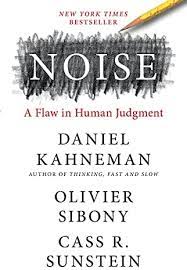“Noise: A Flaw in Human Judgement” is a book written by Daniel Kahneman and Olivier Sibony.
The book provides an in-depth look into how noise affects human judgement and decision-making. The book defines noise as random error or variability in judgment or decision-making that is unrelated to the true state of the world.
The book is for those interested in understanding and improving judgement and decision-making in the presence of noise.
The book explains:
- how noise can lead to errors and inconsistencies in decision-making, and
- how it can obscure the true state of the world and make it difficult to identify patterns or make accurate predictions.
The book also provides a set of practical advice for dealing with noise in judgement, these include:
- Reducing complexity: The authors suggests that simplifying the decision-making process can help to reduce noise. This can be achieved by breaking down complex problems into smaller, more manageable parts, and by focusing on the most critical information.
- Increasing transparency: The authors suggests that increasing transparency in decision-making can help to reduce noise. This can be achieved by clearly communicating the decision-making process and the underlying assumptions, and by being open to feedback and criticism.
- Using decision-making tools: The book suggests that using tools such as decision trees, decision matrices, and statistical models can help to reduce noise. These tools can provide a structured approach to decision-making and help to identify important factors and relationships.
- Managing uncertainty: The book suggests that managing uncertainty can help to reduce noise. This can be achieved by being aware of the limitations of one’s knowledge, by being open to alternative perspectives, and by being willing to revise one’s beliefs in light of new evidence.
- Building a culture of transparency: The book suggests that building a culture of transparency, where decision-making is open and inclusive and where criticism is encouraged, can help to reduce noise. This can be achieved by creating an environment where everyone is encouraged to share their thoughts and ideas.
- Encouraging experimentation: The book suggests that encouraging experimentation can help to reduce noise. This can be achieved by creating a culture where experimentation is seen as a valuable way to learn and improve, and where failure is seen as an opportunity to learn.
The authors argue that these strategies can help to reduce noise and improve judgement and decision-making.
The book has the following sections:
- Introduction: This section provides an overview of the book’s main themes and explains how noise affects human judgement and decision-making.
- Understanding Noise: This section provides a detailed explanation of what noise is, how it affects human judgement, and the different types of noise that exist.
- Noise in the Real World: This section provides examples of how noise affects human judgement in various areas of life, such as finance, healthcare, and politics. It also explores the impact of noise on group decision-making and how it can lead to errors in judgement and decision-making.
- Reducing Noise: This section provides strategies for reducing noise and improving judgement and decision-making. It covers techniques for managing noise, such as reducing complexity, increasing transparency, and using decision-making tools.
- Conclusion: This section summarizes the main points of the book and provides recommendations for future research on noise and its effects on human judgement.
- Appendices: This section includes additional information and resources, such as a glossary of terms, a list of references and bibliography, and other related readings.
Leave a Reply